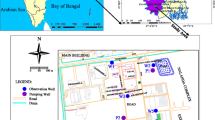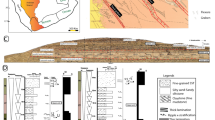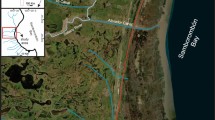Abstract
A characterization study was carried out in a 10-m-thick sandfill, formed by hydraulic filling with marine sand, in Singapore. Placement methods and compaction were found to influence hydrostratigraphy. The deepest part of the sandfill consists of a loose sand layer and is overlain by a medium sand layer extending to mean sea level (MSL). At certain locations, a thin silty-sand layer was found. The different layers within the saturated zone were found to have different values for hydraulic conductivity (K) and groundwater flow velocity. Estimates for K increase according to the following sequence of methods: repacked sand column, step-pumping test, grain-size analysis and slug test. Slug tests and grain-size analysis yielded comparable estimates of K. The freshwater lens in the older part of the sandfill is about 2 m thicker than in a recently completed area. Comparisons of Ca2+/Cl−, Mg2+/Cl−, K +/Cl− and \({\text{Cl}}^{{\text{ - }}} {\text{/}}{\left( {{\text{Cl}}^{{\text{ - }}} {\text{ + HCO}}^{{\text{ - }}}_{{\text{3}}} } \right)}\) ratios indicate that the chemical composition of the groundwater at shallower depths has probably been altered by mineral dissolution. Weathering of carbonate minerals was found to be a major contributor to the major ions at these depths. The molar ratios approach the value for seawater at greater depths. The groundwater is close to equilibrium with calcite.
Résumé
Une étude de caractérisation à Singapour a été réalisée sur un remblayage de 10 mètres d’épaisseur, formé de remblais hydrauliques composés de sable marin. Il est apparu que les méthodes de positionnement et de compaction influencent l’hydrostratigraphie. La partie la plus profonde du remblais est composée d’une couche de sable meuble recouverte par une couche de sable intermédiaire qui s’étend jusqu’au niveau moyen de la mer (MSL en anglais). Une mince couche silto-sableuse a été trouvée au niveau de certaines localisations,. Il est apparu que les différentes couches dans la zone saturée possèdent différentes valeurs de conductivité hydraulique (K) et différentes vitesses d’écoulement de l’eau souterraine. Les estimations de K augmentent suivant la séquence des méthodes suivantes : colonne de sable recompactée, test de pompage par paliers, analyse granulométrique et slug-test. Les slug-tests et l’analyse granulométrique conduirent à des estimations comparables de K. La lentille d’eau douce dans la partie la plus ancienne du remblais est plus épaisse d’environ 2 mètres que dans une zone réalisée récemment. Les comparaisons des rapports Ca2+/Cl−, Mg2+/Cl−, K +/Cl− et \({\text{Cl}}^{{\text{ - }}} {\text{/}}{\left( {{\text{Cl}}^{{\text{ - }}} {\text{ + HCO}}^{{\text{ - }}}_{{\text{3}}} } \right)}\) indiquent que la composition chimique de l’eau souterraine à faibles profondeurs a probablement été altérée par la dissolution de minéraux. L’altération des minéraux carbonatés serait un processus majeur apportant les ions majeurs à ces profondeurs. Les rapports molaires sont proches de la valeur rencontrée pour l’eau de mer à des profondeurs plus importantes. L’eau souterraine est proche de l’équilibre avec la calcite.
Resumen
Un estudio de caracterización se llevó a cabo en un relleno arenoso de 10 m de espesor, formado por un relleno hidráulico con arena marina, en Singapur. Se encontró que los métodos de colocación y consolidación influyen en la hidroestratigrafía. La parte más profunda del relleno de arena consiste en una capa de arena suelta y está cubierto por una capa de arena media que se extiende hasta el nivel medio del mar (MSL). En ciertos lugares, se encontró una capa delgada de arena limosa. Se encontró que las capas diferentes dentro de la zona saturada tienen valores diferentes de conductividad hidráulica (K) y de velocidad del agua subterránea. Los estimativos para K aumentan según la sucesión siguiente de métodos: columna de arena reempacada, prueba de bombeo escalonada, análisis de tamaño de grano y prueba slug. Las pruebas slug y los análisis de tamaño de grano obtuvieron estimativos comparables de K. El lente de agua dulce en la parte más antigua del relleno de arena, es aproximadamente 2 m más espeso que en una área recientemente completada. Las comparaciones entre las relaciones, Ca2+/Cl−, Mg2+/Cl−, K +/Cl− y \({{\text{Cl}}^{{\text{ - }}} } \mathord{\left/ {\vphantom {{{\text{Cl}}^{{\text{ - }}} } {{\left( {{\text{Cl}}^{{\text{ - }}} {\text{ + HCO}}^{{\text{ - }}}_{{\text{3}}} } \right)}}}} \right. \kern-\nulldelimiterspace} {{\left( {{\text{Cl}}^{{\text{ - }}} {\text{ + HCO}}^{{\text{ - }}}_{{\text{3}}} } \right)}}\) indican que la composición química del agua subterránea a las profundidades más someras probablemente se ha alterado por la disolución mineral. Se encontró que la meteorización de minerales del carbonato es un contribuyente mayor para los iones mayores en estas profundidades. Las proporciones de molaridad se acercan el valor para agua de mar a profundidades mayores. El agua subterránea está cerca del equilibrio con la calcita.







Similar content being viewed by others
References
Arulrajah A (2005) Field measurements and back analysis of marine clay geotechnical characteristics under reclamation fills. PhD Thesis, Curtin University of Technology, Australia
Alyamani MS, Sen Z (1993) Determination of hydraulic conductivity from complete grain-size distribution curves. Ground Water 31:551–555
Birsoy YK, Summers WK (1980) Determination of aquifer parameters from step tests and intermittent pumping data. Ground Water 18:137–146
Bo MW, Choa V (2000) Site investigation practice in land reclamation projects. Paper presented at the Year 2000 Geotechnics–Geotechnical Engineering Conference, Bangkok, Thailand, Nov 2000, pp 27–30
Bo MW, Bawajee R, Choa V (2000) Implementation of mega soil improvement works. International Symposium on Coastal Geotechnical Engineering, Yokohama, Japan, 20–22 Sept 2000
Bo MW, Chu J, Low BK, Choa V (2003) Soil improvement: prefabricated vertical drain techniques. Thomson Learning, Singapore, 326 pp
Bo MW, Chu J, Choa V (2005) The Changi east reclamation project in Singapore. In: Indraratna B, Chu J (eds) Ground improvement: case histories. Geo-Engineering Book Series 3, Elsevier, Amsterdam, pp 247–276
Bouwer H (1989) The Bouwer and Rice slug test: an update. Ground Water 27:304–309
Bouwer H, Rice RC (1976) A slug test for determining hydraulic conductivity of unconfined aquifers with completely or partially penetrating wells. Water Resour Res 12:423–428
Cao LF, Na YM, Bo MW, Choa V, Chang MF (1998) Evaluation of sand densification by in-situ tests. Presented at the 2nd International Conference on Ground Improvement Techniques, Singapore, 8–9 October 1998
Chipera SJ, Bish DL (2002) FULLPAT: a full pattern quantitative analysis program for x-ray powder diffraction using measured and calculated patterns. J Appl Crystallogr 35:744–749
Choa V, Bo MW, Chu J (2001) Soil improvement works for Changi east reclamation project. Ground Improv 5:141–153
Domenico PA, Schwartz FW (1990) Physical and chemical hydrogeology. Wiley, New York, 824 pp
Drost W, Klotz D, Koch A, Moser H, Neumaier F, Rauert W (1968) Point dilution methods of interpreting groundwater flow by means of radioisotopes. Water Resour Res 4:125–146
Freeze RA, Cherry JA (1979) Groundwater. Prentice Hall Inc, Englewood Cliffs, New Jersey, 604 pp
Grisak GE, Merritt WF, Williams DW (1977) A fluoride borehole dilution apparatus for groundwater velocity measurements. Can Geotech J 14:554–561
Hall SJ (1993) Single well tracer tests in aquifer characterization. Ground Water Monit Rem 13:118–124
Helweg OJ (1994) A general solution to the step-drawdown test. Ground Water 32:363–366
Lee KM, Shen CK, Leung DHK, Mitchell JK (1999) Effects of placement method on geotechnical behaviour of hydraulic sands. J Geotech Geoenviron Eng 125:832–846
Lunne T, Robertson PK, Powell JJM (1997) Cone penetration testing in geotechnical practice. Taylor and Francis, London, 312 pp
Melville JG, Molz FJ, Gueven O, Widdowson MA (1991) Multilevel slug tests with comparison to tracer data. Ground Water 29:897–907
Millham NP, Howes BL (1995) A comparison of methods to determine K in a shallow coastal aquifer. Ground Water 33:49–57
Na YM (2002) In situ characterization of reclaimed sandfill with particular reference to dynamic compaction. PhD Thesis, Nanyang Technological University, Singapore
Na YM, Choa V, Bo MW, Arulrajah A (1997) Dynamic measurements during dynamic compaction. Proceedings of The 30th Year Anniversary Symposium of The Southeast Asian Geotechnical Society, Bangkok, Thailand, 3–7 Nov 1997
Pitts J (1983) The origin, nature and extent of recent deposits in Singapore. Paper presented at the International Seminar on Construction Problems in Soft Soil, Singapore, 1–3 Dec 1983
Public Works Department (PWD) (1976) Geology of the Republic of Singapore. Public Works Department, Singapore, 79 pp
Robertson PK, Campanella RG (1983) Interpretation of cone penetration test. Part I: Sand. Can Geotech J 20:718–733
Schwartz FW, Zhang HB (2002) Fundamentals of ground water. Wiley, 583 pp
Stumm W, Morgan JJ (1996) Aquatic chemistry: chemical equilibria and rates in natural waters. Wiley, New York, 1022 pp
Vucovic M, Soro A (1992) Determination of hydraulic conductivity of porous media from grain size composition. Water Resources Publications, Highlands Ranch, CO, 83 pp
Yee WK, Chua HCL, Lo YME, Tay JH, Koe CCL, Robertson PA (2004) Use of fluorescein as a groundwater tracer in drift and pumpback test. Paper presented at the 2nd Conference of the Asia Pacific Association for Hydrology and Water Resources, Singapore, 5–9 July 2004
Author information
Authors and Affiliations
Corresponding author
Rights and permissions
About this article
Cite this article
C. Chua, L.H., M. Lo, E.Y., Freyberg, D.L. et al. Hydrostratigraphy and geochemistry at a coastal sandfill in Singapore. Hydrogeol J 15, 1591–1604 (2007). https://doi.org/10.1007/s10040-007-0195-8
Received:
Accepted:
Published:
Issue Date:
DOI: https://doi.org/10.1007/s10040-007-0195-8




